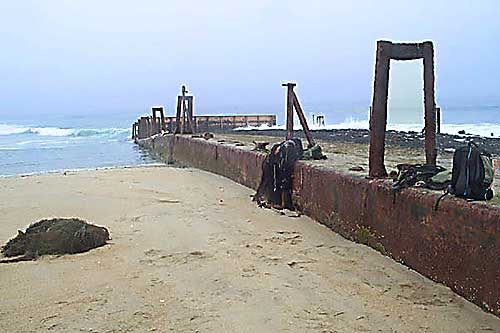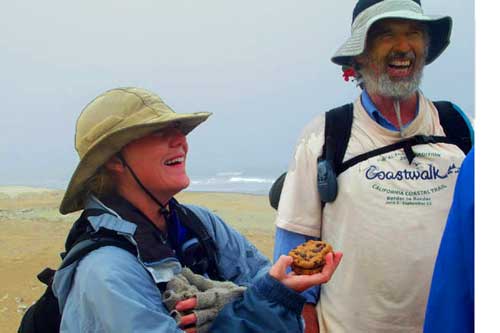


July 29: Monterey County
Moss Landing to Marina State Beach. 8.1 miles
Our walk today was self-guided as we began at Moss Landing, a working harbor at the mouth of Elkhorn Slough. Across Highway One rise the stacks of a huge power plant owned by Duke Energy. We’ve been wonderfully out of the news loop for a long time now and even when we do see a newspaper we mostly only search for news about the walk and here we find ourselves next to one of the big issues in the current recall hubbub. (Ed note: Duke Energy was among the companies that drove the price of California energy up in 2001).
We soon arrived at Salinas River State Beach, walking under very overcast skies. It was just past low tide, so we had good, firm sand to walk on. As the morning wore on, we were forced further and further up the beach by the incoming tide, and as a result by the end of the day’s hike will be walking in loose sand, a situation to avoid whenever possible. For some miles, it appears that this will be a very uneventful day. I’m sure that our mantra of “one step at a time” was being silently repeated by all the walkers. Then we met Jenny Erbes and our day changed. Jenny, like Ryan yesterday, works for the Point Reyes Bird Observatory, and is monitoring the Snowy Plovers (rhymes with lovers) on this section of the beach. Today is a very special day: one of the nests she monitors has an hours’ old hatchling and two eggs due at any time. In association with her work, she has been granted a “20 minute pass” from the National Fish and Wildlife Service. This means that she can visit a nest site but for no more than 20 minutes, and she can let others observe also. We walked single file, no more than three at a time, behind Jenny past the barrier rope separating the beach from the back beach area, and there is the nest. A plover nest is not what you would expect. No soft down to comfort these birds, just a slight depression in the sand. You could literally walk on it without ever knowing that it was there. That is why a barrier rope has had to be installed. We gaze down on the little chick, already banded, and with its egg tooth still attached to the beak. Beside it are two speckled eggs likely to hatch this same day. Within hours of hatching these small birds will be out on their own, catching and feeding on beach flies. The male plover will watch over them for approximately one month. The female has already left for a new mate and a new nest. We gave Jenny some cookies for her lunch and reluctantly leave her and our plover friends. (For more on plovers: http://www.friendsofthedunes.org/snowy.plover/photo/plover.banner.jpg)
Soon we came upon an old beached barge. It lies at an angle to the beach with perhaps 50 feet or so jutting out into the ocean. Waves on the wind side crash upon it with some ferocity but on the lee side, it was a different story. Here the water was calmer and the waves more gentle. The water was not too deep, perhaps 4 feet, and with each incoming swell, a phenomenon takes place on the sandy sea floor. As soon as the water begins rushing landward, the seabed comes alive with myriads of sand crabs. They appear, rush about, and; as the motion of the water subsides, burrow back into the sand. The rest of our walk, a mile or two at best, was anti-climatic. We trudge through the soft sand and arrive at Marina State Park. It is only noon so we take our lunch at some picnic tables and then continue inland along Reservation and Dunes Roads to the Marina RV Park, our destination for the day. (Jon Breyfogle; photo by Linda Hanes. Egg photo: Friends of the Dunes)
Left: Barge on Salinas River beach. Right: Snowy plover monitor Jenny Erbes rewarded with cookies. Steve Jones looks on.
